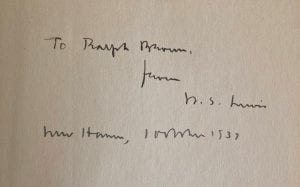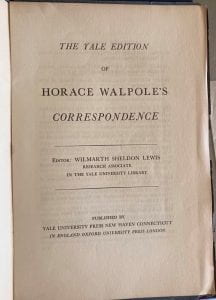by Neil Guthrie, FSA, FSAScot, Co-editor The Scriblerian and the Kit-Cats

The author’s set of the Yale edition of Horace Walpole’s correspondence
Before the onset of Covid, I bought a full set of the Yale edition of Walpole’s correspondence.
It belonged to Ralph Brown, who worked as a junior editor on the Montagu volumes and dutifully acquired each volume as it was published, right to the end in 1983.

Manuscript inscription “To Ralph Brown, / from / W.S. Lewis / New Haven, 1 October 1937”
The set includes the scarce prospectus for the project, and volume 1 is inscribed ‘To Ralph Brown, / from / W.S. Lewis / New Haven, 1 October 1937’.

Prospectus for “The Yale Edition of Horace Walpole’s Correspondence”
Brown went on from Walpole and Montagu to a distinguished career as a law professor. My suspicion, judging by the tightness of the binding of the later volumes, is that he may not actually have read all 48. I did do that, and I’m pleased to say that two articles have resulted from the undertaking.
The first appeared recently in The Book Collector and tells the story of the purchase and the difficulties of getting the books delivered from the bookseller in New Haven to me in Toronto.[1] This was not an easy (or inexpensive) process. The original plan was for me to drive to New Haven one week-end, but then the pandemic closed the Canada-US border to non-commercial vehicles. I managed to find an art shipper managed to do it, and the 48 volumes found their way onto purpose-built shelves in my study.
I took notes as I read, not with any specific objective in mind beyond the pleasure of the letters and the interesting facts, opinions, and anecdotes they revealed. My previous scholarly work has been on Jacobitism, so I was naturally interested to be reminded of Walpole’s never complimentary remarks about the exiled Stuarts, especially in the correspondence with Sir Horace Mann. I also became reacquainted with Walpole himself, and in much more detail than I previously knew him. Having read Matthew Reeve’s study of gothic architecture and sexuality in Walpole’s circle, I looked for clues to Walpole’s sexual identity or orientation, knowing full well that the record, while extensive, would be partial by design and by circumstance.[2] No smoking guns, as George Haggerty has observed.[3]
What intrigued me was not so much what Walpole and his correspondents expressed about their own sexual and romantic affairs as how Walpole reacted to other men we can usefully describe as queer. In particular, the combination of almost visceral distaste and fascination that resulted from his indirect dealings with the bisexual libertine Baron Philipp von Stosch, and his feigned lack of interest in the flamboyant Cardinal Prince Henry Benedict (Duke of York in the Jacobite peerage, the younger of the Old Pretender’s two sons) suggested the second article, which is forthcoming in Eighteenth-Century Life.[4]

Horace Walpole, from a mezzotint by James Macardell after the portrait by Sir Joshua Reynolds.
I suggest there that Walpole’s strong reactions to both men, which he concealed even from Mann, reveal anxieties that do not surface (or at least not as much) in his interactions with less outré queer men like Mann and John Chute. It is as though Walpole felt safe with his intimates as long as they kept largely to themselves, but was alarmed that parallels might be drawn between him and the very out Stosch and Cardinal York. I am conscious that much of the material from the correspondence will be well known to readers of Walpole, and I did not find a smoking gun that had been overlooked by Haggerty or others; but I think the focus on the Prince and the Baron adds nuance to our understanding of Horace Walpole and the eighteenth-century sexualities, identities, and queer cultures he navigated over the course of his life and letter-writing.
I aired my ideas about Walpole, Cardinal York and Stosch at a Lewis Walpole virtual coffee earlier this year. Susan Walker was very helpful in providing answers to queries and scans of manuscript material at Farmington, which I hope to visit again soon.
[1] “Reading Horace Walpole: A Pandemic Project”, The Book Collector 72:1 (spring 2023), 81-5.
[2] Gothic Architecture and Sexuality in the Circle of Horace Walpole (University Park, Penn.: Penn State University Press, 2020).
[3] “Queer Feelings: Love and Loss in the Letters of Horace Walpole”, Humanities 10 (2021), 108.
[4] “Horace Walpole, the Prince, and the Baron”, forthcoming in Eighteenth-Century Life.
